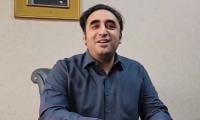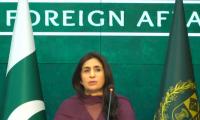The writer holds a PhD from the University of Birmingham, UK and works in Islamabad.
It is difficult to select the best book from over a 100 odd books that Dr Mubarak Ali has written. The very first booklet by him that I read proved to be eye-opening. This was early 1980s and I was a college student in Karachi and associated with the Democratic Students Federation (DSF).
That was the time when senior comrades such as my father used to engage the young ones to read progressive literature. Most of them had devoured Sibte Hasan’s books such as 'Musa Se Marx Tak' (From Moses to Marx) and 'Mazi Ke Mazar' (The tombs of the past). But there was a dearth of good history books in Urdu, and Dr Mubarak Ali has been tirelessly trying to fill that void for the past 40 years. So the first booklet by Dr Mubarak Ali that I got hold of was titled ‘Sindh Ki Tareekh Kaise Likhni Chahiye’ (How to write the history of Sindh).
Agahi Publications Hyderabad had published that book in 1983 and I still have that one with me. An interesting feature of that booklet was that Dr Mubarak Ali himself was the calligrapher of his lecture delivered in June 1983 at a forum of Sindh University. He wrote and published it, selling at just seven rupees. It was not his first booklet, as it had mentioned his other writings at the back flap, for example: 'Tareekh Kya Hai? (What is history?) for seven rupees, and 'Tareekh Aur Shaoor' (History and consciousness) just for eight.
The booklet also mentioned that his book 'Aakhri Ehdey Mughlia ka Hindustan' (India in the later Mughal period) would soon be available. Agahi Publications was introduced as a writers’ collective formed on a self-help and non-commercial basis aimed at raising awareness among people. Its editorial board comprised Dr Hasan Manzar, Zubaid Firdausi, Fariduddin, and Dr Mubarak Ali himself. They also clarified that to ensure its editorial independence, it did not accept any donations or financial aid, and neither did it seek any advertisements. The path of awareness-raising that Dr Mubarak Ali embarked on 40 years ago, he has diligently followed with his ceaseless efforts.
That 25-page booklet explaining how to write history of Sindh was unusual; it was not history but about historiography. Despite being Marxist in orientation, the booklet did not use heavy Marxist jargon, nor did it refer to Marx and Lenin or discussed dialectical and historical materialism with their focus on qualitative and quantitative transformations. For example, just look at its first paragraph: “Usually we consider history a frozen and stagnant discipline which never changes and neither does it have any alterations. It is a fact that events long past cannot change, but explanations and interpretations of history regularly develop. Events are the same but each generation wants to look at those events in light of changing ideas, traditions, and values.”
If you apply this to some major countries of the world such as America, China, India, and even Russia, you realize that the history of China or India written just 50 or hundred years ago is being looked at in the light of new ideas and ideologies. The histories of America written a 100 years back about black people or the natives are being scrutinized with new norms and values. The same applies to Russia where new explanations and interpretations have appeared about the Soviet history written before the 1980s.
Dr Mubarak Ali has taught us the art of understanding historiography more than history itself. A majority of the old Soviet history that claimed to be Marxist now appears to be outdated and irrelevant, whereas the writings of Dr Mubarak Ali are still as powerful as they were decades ago. In the same booklet he continues: “We should keep giving new explanations and meanings to events so that we can comprehend the past with new perspectives. History is a discipline from which society gains historical consciousness. Not only that, each era has different expositions but also in each period new schools of historiography emerge. The ruling elite gets history written in accordance with its own viewpoint to give strength to its power base. In contrast, pro-people historians write history from a people’s perspective to generate historical awareness in light of which people can continue their struggle.”
You can easily apply this to India, Pakistan, or Russia. When the Soviet Communist Party was in power, they wrote history differently. In India, now the BJP is in power and has tried to get their history written per their own desires. So, are all these histories correct? Dr Mubarak Ali responds with the following words: “No matter whatever viewpoint you take, it is necessary that historical facts are not mutilated, rather we should analyze and scrutinize them in an objective manner because – particularly today – we cannot hide or mutilate events.”
Be it America, India, Pakistan or Russia, everywhere the ruling elite tries to beat the history into a desired shape to extract their favourite version. Perhaps, Dr Mubarak Ali is the first historian who has pointed out that in Pakistan there are rare historians who explain history with an objective and people’s perspective. Once you develop this feeling, you read and write history books and historical sources with a different angle and then tend to dislike official versions of history. In that booklet, Dr Mubarak Ali has highlighted that our official history books have played a deplorable role in harnessing the development of democratic values in Pakistan.
After that first booklet, being out of the country I could not read any other book by him for five years. But while living in the Soviet Union I could recall Dr Mubarak Ali’s warnings about history. Is this Soviet history authentic and real? Or should I apply the same logic that the dominant class develops and encourages history that suits it. Later events proved that this logic was applicable to communist societies as much. For instance, the Soviet histories before and after Khrushchev are quite different. The same applies to pre- and post-Gorbachev histories.
A historian’s’ task is to attempt an objective analysis of multiple histories with a people’s perspective, and not ‘for’ or ‘against’ any one class or party. After coming back to Pakistan in 1988, the first books that I read by Dr Mubarak Ali were again two booklets about the Arab and Mughal periods in the history of Sindh. In addition, a third booklet that I still have in my collection was titled ‘Imperialism Kya Hai?’ (What is imperialism?) Nigarishat Lahore had published these booklets and in five years’ time his books had garnered considerable popularity and he no more had to copy and publish on his own.
The books on the history of Sindh were in continuation of his earlier booklet about how to write history. These two books clarified many ambiguities. Writing about Arab rule in Sindh, Dr Mubarak Ali explained that there was no historical source about Brahman and Rai dynasties before the Arabs. We can only get something from Chach Nama that was written from an Arab perspective of conquest. If we understand this point we start looking at the advent of Muhammad bin Qasim and the official narrative of the events and happenings with suspecting eyes and try to look for more sources.
Dr Mubarak Ali writes that the second significant source on the history of Sindh is ‘Futuh al-Buldan’ (Book of the Conquests of Lands) by the 9th-century Arab-Persian historian Yahya al-Baladhuri who narrated events with laconic brevity. Dr Mubarak Ali cautions, “If we can verify the accounts of travelers with other contemporary sources, we may consider them reliable to some extent, if not then they are normally superficial statements.” Later Muslim historians selected only those texts from travelers’ accounts that projected Arab rule as magnificent and tried to prove that Sindh under their control was economically and financially a developed province.
To be continued
Email: mnazir1964@yahoo.co.uk
A woman walks past a building of the International Monetary Fund. — AFP/FileThe annual and spring meetings of the...
Late Benazir Bhutto's daughter Asifa Bhutto Zardari addresses the Christian community in Bihar Colony on January 23,...
Representational image. — PexelsWater is an important scarce natural resource that is required for several everyday...
Pakistani employees of online marketplace company Kaymu at work in Karachi. — AFP/FileThe true spirit of development...
India uses Afghanistan as a backstage area to carry out terrorist attacks against Pakistan
Another report by the Pakistan Institute of Peace Studies states that 78 per cent of attacks have been carried out by...







